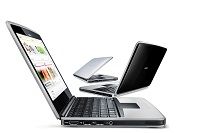The Nokia's keyboard layout is good: the keys have a reasonable amount of travel and are quite well spaced out, at least for a netbook. The keys are set well back from the casing, giving a generous and again Apple-like wrist wrest. This, and the aluminium design, makes the computer more stable to type on than some cheaper netbooks, which have a tendency to topple backwards.
The Booklet 3G's ports are arranged to the sides of the machine. It comes equipped with three USB ports, and an HDMI port for external monitors or TVs (but no VGA). On the right hand side, a cover conceals an SD card slot and a SIM card slot for 3G/HSDPA connections. The Booklet supports 802.11n Wi-Fi, but there is no wired Ethernet port.
The screen is a 10.1in (1280x720 pixels) unit coated with an anti-reflective foil: this was sharp and performed well in a wide range of lighting conditions. Above the screen, Nokia has fitted a 1.3 megapixel webcam now a pretty standard feature on netbooks.
There is a single 3.5mm headphone jack, so to use the Booklet for Internet telephony or Skype, buyers will need a Bluetooth or USB headset, or a OMTP-compatible unit. Fortunately, Nokia includes a suitable headset, the WH-205, in the box. The computer also comes with a reasonably compact mains adapter, and a USB charging cable for connecting Nokia phones.














